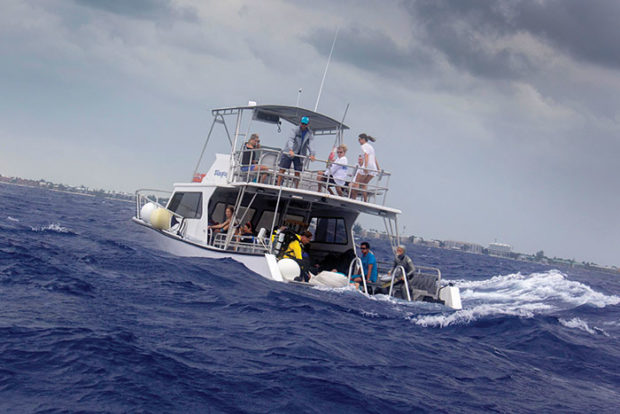Dealing with seasickness
There’s nothing worse than gearing up a boat dive only to have your tummy lurching within minutes of leaving the dock. Fly & Sea Dive Adventures are there with you…

Choose the right destination
Don’t choose a destination where you have to hit the open ocean in the middle of monsoon season to reach a dive site. Try to pick areas with sites within protected harbours or seas to minimize the amount of waves you must battle. In addition, if you are considering a liveaboard, choose a larger ship with a built-in stabilization system.
Rest before departure
Feeling exhausted is a good way to make your body more susceptible to motion sickness. Take a night to get some good sleep before you board your next boat trip.
Get some fresh air
Being stuck in the interior of a boat can amplify the effects of sea sickness. Fresh air has two benefits: allowing our minds to focus on the wind blowing on our face and removing us from the oppression of a confined space.
Look at the horizon
Looking at the horizon helps our eyes to correct the signal they are sending to the brain. As the eyes look at the moving horizon, they begin to realize the movement of the boat and match the information the inner ear is sending. Correcting this miscommunication is the best way to manage sea sickness.
Mid-ship near the water
This is the location where a boat’s unnatural movements are minimized the most. If you are sailing on a liveaboard, request a cabin near the middle of the boat with a window looking out to the sea.
Eat something
Contrary to popular belief, sailing on an empty stomach will not prevent you from throwing up. A light, non-greasy meal is the best breakfast before heading out. Try taking along some ginger cookies to snack on every couple of hours. Ginger is commonly thought to minimize the effects of motion sickness.
Drink something
Coca-cola contains phosphoric acid and sugars, the very same ingredients you will find in common anti-nausea drugs.
Take some drugs
12 to 24 hours before setting sail, consider over-the-counter anti-nausea drugs like Dramamine or Bonine. These work by blocking the miscommunications your eyes, feet and inner-ears are sending to your brain. However, side effects can include drowsiness, so best give them a trial before diving.
Wear a patch
These are worn behind your ear, and work by reducing the signals sent by the nerves of your inner ear. As with over-the-counter pills, you must be mindful of the side effects which can include blurred vision and dry mouth.
Try an acupressure wristband
These bands put pressure on a point of the wrist called P6. While the science behind the technique is still being tested, many people believe that bands remedy the nausea caused by seasickness.
For more visit: www.flyandsea.com







